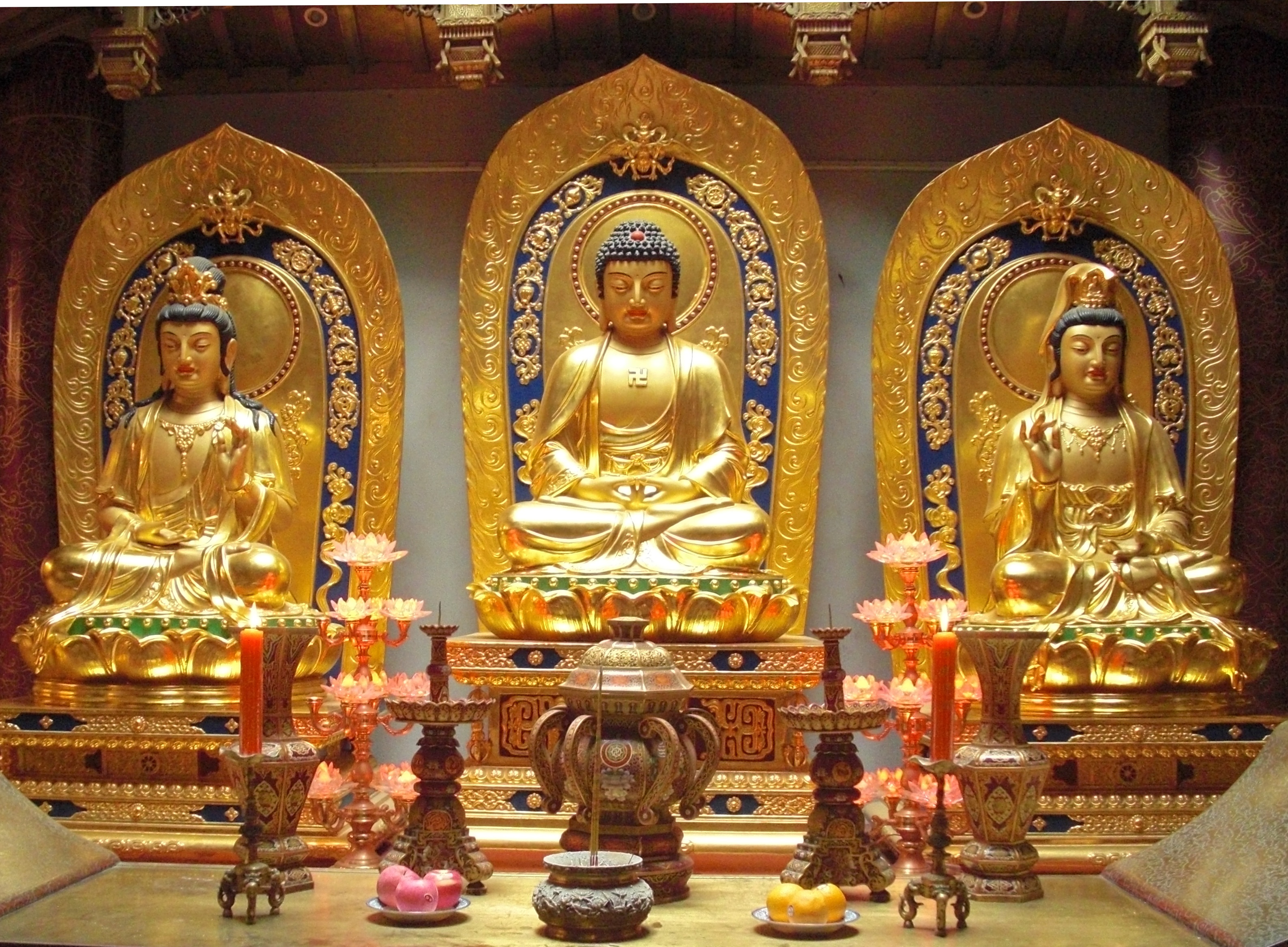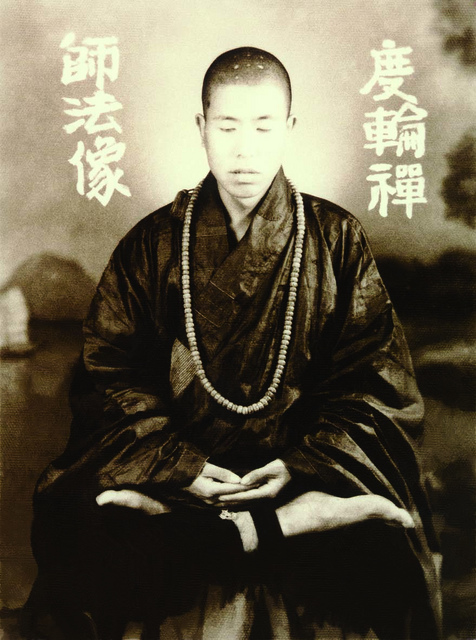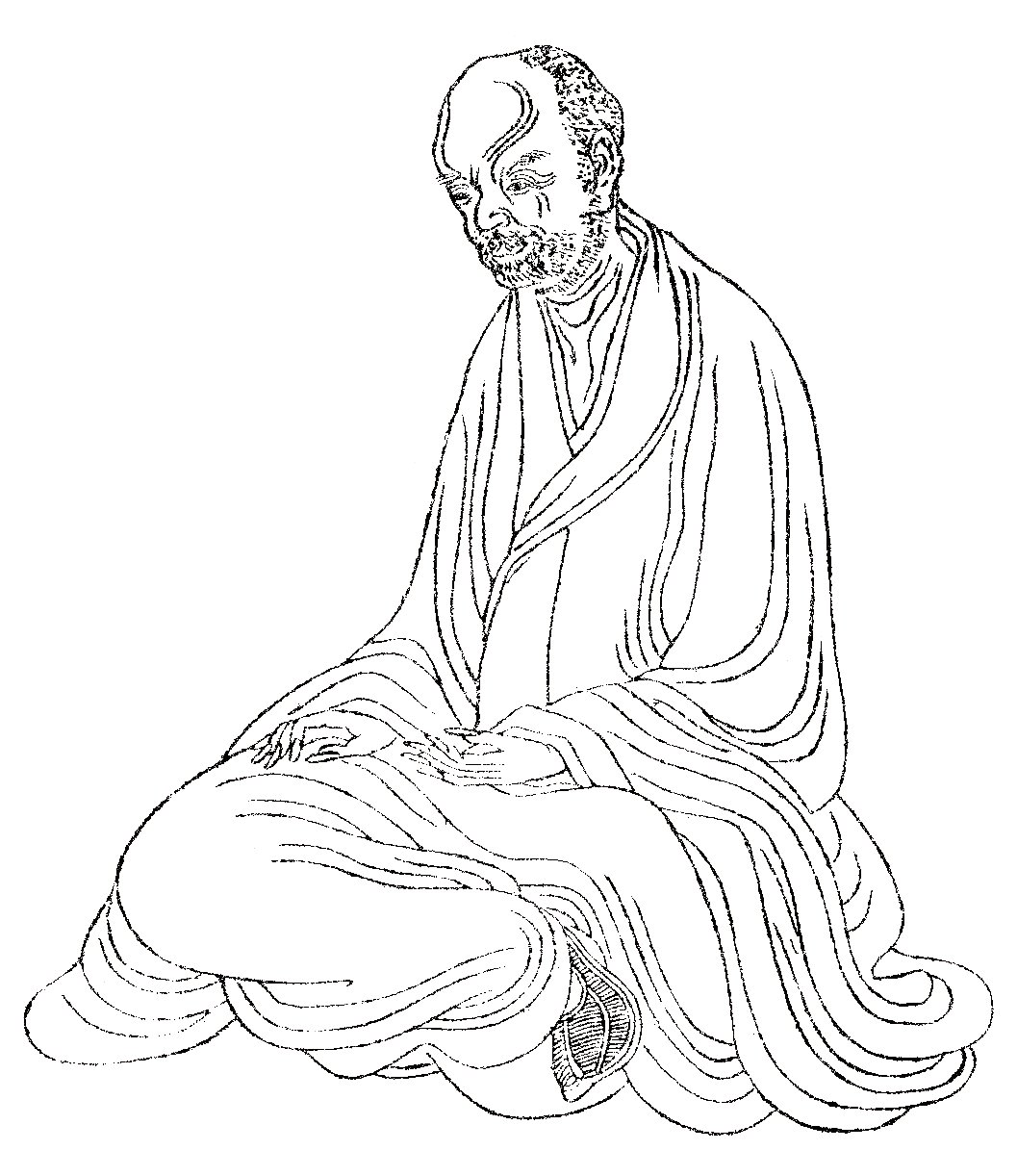|
Fazhao
Fǎzhào (Chinese: 法照; J. Hōshō; 746–838), also known as Zhulin Fazhao (竹林法照) and Śramaṇa Fazhao of Nanyue, was a Chinese monk during the Tang dynasty, known for his teachings on Pure Land Buddhism and nianfo (recitation of Buddha Amitābha, Amitābha's name).Kai, S. (2020). "The Pure Land Teachings of Fazhao and the Mañjuśrī Cult of Mount Wutai". In ''The Transnational Cult of Mount Wutai''. pp. 288-306. Leiden, The Netherlands: Brill. https://doi.org/10.1163/9789004419872_013Callahan, Christopher. "Recognizing the Founder, Seeing Amida Buddha Kakunyo’s Hōon kōshiki", ''Japanese Journal of Religious Studies'' 43/1: 177–205 © 2016 Nanzan Institute for Religion and Culture http://dx.doi.org/10.18874/jjrs.43.1.2016.177-205 He was honored by Chinese emperor Emperor Daizong of Tang, Daizong with the title "National Teacher of the Bamboo Grove temple of the Central Terrace [of the Mount Wutai, Wutai Mountains]" and was later honored as a patriarch of the Pure ... [...More Info...] [...Related Items...] OR: [Wikipedia] [Google] [Baidu] |
Pure Land Buddhism
Pure Land Buddhism or the Pure Land School ( zh, c=淨土宗, p=Jìngtǔzōng) is a broad branch of Mahayana, Mahayana Buddhism focused on achieving rebirth in a Pure land, Pure Land. It is one of the most widely practiced traditions of East Asian Buddhism, Buddhism in East Asia. It is also known as the "Lotus School" (Chinese language, Chinese: 蓮宗; pinyin: ''Liánzōng'') in China or the "Nianfo, Nembutsu school" in Japan. East Asian Pure Land mainly relies on three main Mahayana sutras, Mahayana scriptures: the ''Longer Sukhāvatīvyūha Sūtra, Sutra of Amitayus'', the ''Amitāyus Contemplation Sūtra, Contemplation Sutra'' and the ''Shorter Sukhāvatīvyūha Sūtra, Amitabha Sutra''. The Pure Land tradition is primarily focused on achieving rebirth in a Buddhahood, Buddha's "pure land", a superior place to spiritually train for full Buddhahood, where one can meet a Buddha face to face and study under them without any of the distractions or fears of our world.Williams, Pau ... [...More Info...] [...Related Items...] OR: [Wikipedia] [Google] [Baidu] |
Shandao
Shandao (; ; 613–681) was a Chinese Buddhist scholar monk and an influential figure of East Asian Pure Land Buddhism.Jones (2019), pp. 20-21 Shandao was one of the first Pure Land authors to argue that all Pṛthagjana, ordinary people, and even the most evil person, can be reborn in the Pure land, Pure Land by relying on the Other power, karmic power of Amitābha Buddha's Primal Vow, past vows. Shandao was also one of the earliest Pure Land authors to teach the primacy of faithfully reciting Amitābha's name (Ch: nianfo). Shandao saw this practice as sufficient for birth in the Pure Land, and as the supreme practice (even more important than Buddhist meditation, meditation). This, along with Shandao's efforts to teach common laypeople in various ways, like disseminating paintings of the Pure Land, made Pure Land Buddhism much more accessible and popular among the common people. Several modern scholars consider Shandao to be the central figure of the Chinese Pure Land traditi ... [...More Info...] [...Related Items...] OR: [Wikipedia] [Google] [Baidu] |
Nianfo
250px, Chinese Nianfo carving The Nianfo ( zh, t= 念佛, p=niànfó, alternatively in Japanese ; ; or ) is a Buddhist practice central to East Asian Buddhism. The Chinese term ''nianfo'' is a translation of Sanskrit '' '' ("recollection of the Buddha"), a classic Buddhist mindfulness (smṛti) practice. Nianfo focused on the Buddha Amitābha is also the most important practice in Pure Land Buddhism. In the context of East Asian Pure Land practice, nianfo typically refers to the oral repetition of the name of Amitābha through the phrase "Homage to Amitabha Buddha" ( Ch: 南無阿彌陀佛, Mandarin: Nāmó Āmítuófó, Jp: Namu Amida Butsu; from the Sanskrit: Namo'mitābhāya Buddhāya). It can also refer to that phrase itself, in which case it may also be called ''the'' nianfo, or "The Name" (Japanese: ''myōgō'' 名号). In most extant Pure Land traditions, faithfully reciting the name of Amitābha is mainly seen as a way to obtain birth in Amitābha's pure land of ... [...More Info...] [...Related Items...] OR: [Wikipedia] [Google] [Baidu] |
Pratyutpanna Samādhi Sūtra
The ''Pratyutpanna Samādhi Sūtra'' (Sanskrit; ; Vietnamese: Kinh Bát Chu Tam Muội) is an early Mahayana Buddhist scripture, which probably originated between the 1st century BCE and 2nd century CE in the Gandhara area of northwestern India. The full title for this text is ''Pratyutpannabuddha Saṃmukhāvasthita Samādhi Sūtra'', which translates to, "Sūtra on the Samādhi for Encountering Face-to-Face the Buddhas of the Present". The ''Pratyutpanna'' is a particularly important Mahayana sutra in East Asian Pure Land Buddhism and Tiantai (Jp: Tendai) Buddhism, since it contains key teachings on Buddha contemplation and Buddha recollection (nianfo). It is the main source for the Tiantai school's "constantly walking samadhi" practice (taught in Zhiyi's '' Mohe Zhiguan''), also known as the pratyutpanna-samādhi (the meditative absorption of direct encounter f the Buddhas. The sutra was commented on and relied upon by numerous Chinese Pure Land masters, like Huiyuan, Sha ... [...More Info...] [...Related Items...] OR: [Wikipedia] [Google] [Baidu] |
Cimin Huiri
Cimin Huiri (Chinese: 慈悞慧日, pinyin: Címǐn Huìrì; Japanese: Jimin Enichi, c. 680–748) was a figure in Chinese Pure Land Buddhism and the founder of the Cimin lineage within this tradition. Born in 680 during the Tang dynasty, Huiri emerged as one of the most influential defenders of the Pure Land School against the critiques of the Southern school of Chan Buddhism.Buswell, Robert E; Lopez, Donald S. The Princeton Dictionary of Buddhism, p. 193. Princeton University Press, Nov 24, 2013.Chappell, David W.. "From Dispute to Dual Cultivation: Pure Land Responses to Ch'an Critics". ''Traditions of Meditation in Chinese Buddhism'', edited by Peter N. Gregory, Honolulu: University of Hawaii Press, 1986, pp. 163–198. https://doi.org/10.1515/9780824842932-007 Overview Life Inspired by the pilgrimage of the translator Yijing (意靖; 635–713), Huiri embarked on a journey to India in 702. Traveling by sea, he reached the Indian subcontinent in 704 and remained there unt ... [...More Info...] [...Related Items...] OR: [Wikipedia] [Google] [Baidu] |
Amitābha
Amitābha (, "Measureless" or "Limitless" Light), also known as Amituofo in Chinese language, Chinese, Amida in Japanese language, Japanese and Öpakmé in Tibetan script, Tibetan, is one of the main Buddhahood, Buddhas of Mahayana, Mahayana Buddhism and the most widely venerated Buddhist deities, Buddhist figure in East Asian Buddhism.阿彌陀 Amitâbha Digital Dictionary of Buddhism Amitābha is also known by the name Amitāyus ("Measureless Life"). Amitābha is the main figure in two influential Indian Buddhist Mahayana sutras, Mahayana Scriptures: the ''The Amitāyus Sutra, Sutra of Measureless Life'' and the ''Amitābha Sūtra''. According to the ''Sutra of Measureless Life'', Amitābha established a Pure Land, pure land of perfect peace and happiness, called Sukhavati, Sukh ... [...More Info...] [...Related Items...] OR: [Wikipedia] [Google] [Baidu] |
Prajnaparamita
file:Medicine Buddha painted mandala with goddess Prajnaparamita in center, 19th century, Rubin.jpg, A Tibetan painting with a Prajñāpāramitā sūtra at the center of the mandala Prajñāpāramitā means "the Perfection of Wisdom" or "Transcendental Knowledge" in Mahayana, Mahāyāna. Prajñāpāramitā refers to a perfected way of seeing the Ontology, nature of reality, as well as to a particular body of Mahayana sutras, Mahāyāna scriptures (sūtras), known as the Prajñāpāramitā sutras, which includes such texts as the Heart Sutra and Diamond Sutra. The word ''Prajñāpāramitā'' combines the Sanskrit words ''Prajñā (Buddhism), prajñā'' "wisdom" (or "knowledge") with ''pāramitā'', "excellence," "perfection," "noble character quality," or "that which has gone beyond," "gone to the other side," "Transcendence (philosophy), transcending." Prajñāpāramitā is a central concept in Mahāyāna Buddhism and is generally associated with ideas such as emptiness (''ś� ... [...More Info...] [...Related Items...] OR: [Wikipedia] [Google] [Baidu] |
Dhyana In Buddhism
In the oldest texts of Buddhism, ''dhyāna'' () or ''jhāna'' () is a component of the training of the mind (''bhavana''), commonly translated as Buddhist meditation, meditation, to withdraw the mind from the automatic responses to sense-impressions and "burn up" the Kleshas (Buddhism), defilements, leading to a "state of perfect equanimity and awareness (''Upekṣā, upekkhā-Sati (Buddhism), sati-Purity in Buddhism, parisuddhi'')." ''Dhyāna'' may have been the core practice of pre-sectarian Buddhism, in combination with several related practices which together lead to perfected mindfulness and detachment. In the later commentarial tradition, which has survived in present-day Theravada, Theravāda, ''dhyāna'' is equated with "concentration", a state of one-pointed absorption in which there is a diminished awareness of the surroundings. In the contemporary Theravāda-based Vipassana movement, this absorbed state of mind is regarded as unnecessary and even non-beneficial for t ... [...More Info...] [...Related Items...] OR: [Wikipedia] [Google] [Baidu] |
Emperor Dezong Of Tang
Emperor Dezong of Tang (27 May 742According to Li Kuo's biography in the ''Old Book of Tang'', he was born on the ''guisi'' day in the 4th month of the 1st year of the ''Tianbao'' era of Tang Xuanzong's reign. This date corresponds to 27 May 742 in the Julian calendar.(「天宝元年四月癸巳,生于长安大内之东宫。」) ''Old Book of Tang'', vol. 12. – 25 February 805),According to Li Kuo's biography in the ''Old Book of Tang'', he died on the ''guisi'' day in the 1st month of the 21st year of the Zhenyuan era of his reign, at the age of 64 (by East Asian reckoning). This date corresponds to 25 Feb 805 in the Gregorian calendar.「(贞元)二十一年春正月...癸巳,....。是日,上崩于会宁殿,享寿六十四。」) ''Old Book of Tang'', vol. 13. personal name Li Kuo, was an emperor of the Chinese Tang dynasty. He was the oldest son of Emperor Daizong. His reign of 26 years was the third longest in the Tang dynasty (surpassed only by Emperor Xuanzon ... [...More Info...] [...Related Items...] OR: [Wikipedia] [Google] [Baidu] |
Lushan Huiyuan
Lushan Huiyuan (; 334–416 AD), meaning "Huiyuan of Mount Lu", was a Chinese Buddhist teacher who founded Donglin Temple at the foot of Mount Lu in Jiujiang province and wrote the text ''On Why Monks Do Not Bow Down Before Kings'' in 404 AD. He was born in Shanxi province but moved to Jiujiang, where he died in 416. Although he was born in the north, he moved south to live within the bounds of the Eastern Jin Dynasty. Huiyuan was posthumously named First Patriarch of the Pure Land School of Buddhism, and founder of the White Lotus Society, an early Buddhist community devoted to Amitabha Buddha. His disciples included Huiguan (), Sengji (), and Faan (). Life Huiyuan began studying the ''Zhuangzi'', ''Laozi'', and the teachings of Confucius at a young age. However, at the age of 21 he was converted to Buddhism in Hebei Province by the monk Dao An, a Chinese disciple of a Kuchan missionary. Hearing the sermons of Dao An convinced Huiyuan to "leave the family" and embark on a ... [...More Info...] [...Related Items...] OR: [Wikipedia] [Google] [Baidu] |
Tang Dynasty
The Tang dynasty (, ; zh, c=唐朝), or the Tang Empire, was an Dynasties of China, imperial dynasty of China that ruled from 618 to 907, with an Wu Zhou, interregnum between 690 and 705. It was preceded by the Sui dynasty and followed by the Five Dynasties and Ten Kingdoms period. Historians generally regard the Tang as a high point in Chinese civilisation, and a Golden age (metaphor), golden age of cosmopolitan culture. Tang territory, acquired through the military campaigns of its early rulers, rivalled that of the Han dynasty. The House of Li, Li family founded the dynasty after taking advantage of a period of Sui decline and precipitating their final collapse, in turn inaugurating a period of progress and stability in the first half of the dynasty's rule. The dynasty was formally interrupted during 690–705 when Empress Wu Zetian seized the throne, proclaiming the Wu Zhou dynasty and becoming the only legitimate Chinese empress regnant. The An Lushan rebellion (755 ... [...More Info...] [...Related Items...] OR: [Wikipedia] [Google] [Baidu] |
Dharmas
The Abhidharma are a collection of Buddhist texts dating from the 3rd century BCE onwards, which contain detailed scholastic presentations of doctrinal material appearing in the canonical Buddhist scriptures and commentaries. It also refers to the scholastic method itself, as well as the field of knowledge that this method is said to study. Bhikkhu Bodhi calls it "an abstract and highly technical systemization of the uddhistdoctrine," which is "simultaneously a philosophy, a psychology and an ethics, all integrated into the framework of a program for liberation." According to Peter Harvey, the Abhidharma method seeks "to avoid the inexactitudes of colloquial conventional language, as is sometimes found in the Suttas, and state everything in psycho-philosophically exact language." In this sense, it is an attempt to best express the Buddhist view of "ultimate reality" (''paramārtha-satya''). There are different types of Abhidharma literature. The early canonical Abhidharma w ... [...More Info...] [...Related Items...] OR: [Wikipedia] [Google] [Baidu] |








